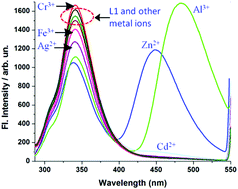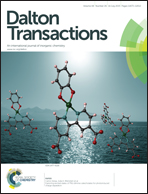X-ray structurally characterized sensors for ratiometric detection of Zn2+ and Al3+ in human breast cancer cells (MCF7): development of a binary logic gate as a molecular switch†
Abstract
A very simple molecule derived from salicylaldehyde and N-phenyl ethylenediamine (L1) functions as dual-mode ratiometric fluorescence “turn on” sensors for Zn2+ and Al3+ at two different wavelengths. The sensing is based on the combined effect of inhibition of excited-state intra-molecular proton transfer (ESIPT), CH![[double bond, length as m-dash]](https://www.rsc.org/images/entities/char_e001.gif) N isomerization and chelation-enhanced fluorescence (CHEF). Moreover, the [L1–Zn2+] system functions as a better Al3+ sensor where Al3+ ratiometrically displaces Zn2+ from the [L1–Zn2+] complex. Emission wavelength dependent differentiation of Zn2+ and Al3+ using L1 allows us to develop a binary logic gate that functions as a molecular switch. L1 efficiently detects Zn2+ and Al3+ in human breast cancer cells (MCF7) while the [L1–Zn2+] complex specifically detects Al3+ in the said cells.
N isomerization and chelation-enhanced fluorescence (CHEF). Moreover, the [L1–Zn2+] system functions as a better Al3+ sensor where Al3+ ratiometrically displaces Zn2+ from the [L1–Zn2+] complex. Emission wavelength dependent differentiation of Zn2+ and Al3+ using L1 allows us to develop a binary logic gate that functions as a molecular switch. L1 efficiently detects Zn2+ and Al3+ in human breast cancer cells (MCF7) while the [L1–Zn2+] complex specifically detects Al3+ in the said cells.


 Please wait while we load your content...
Please wait while we load your content...